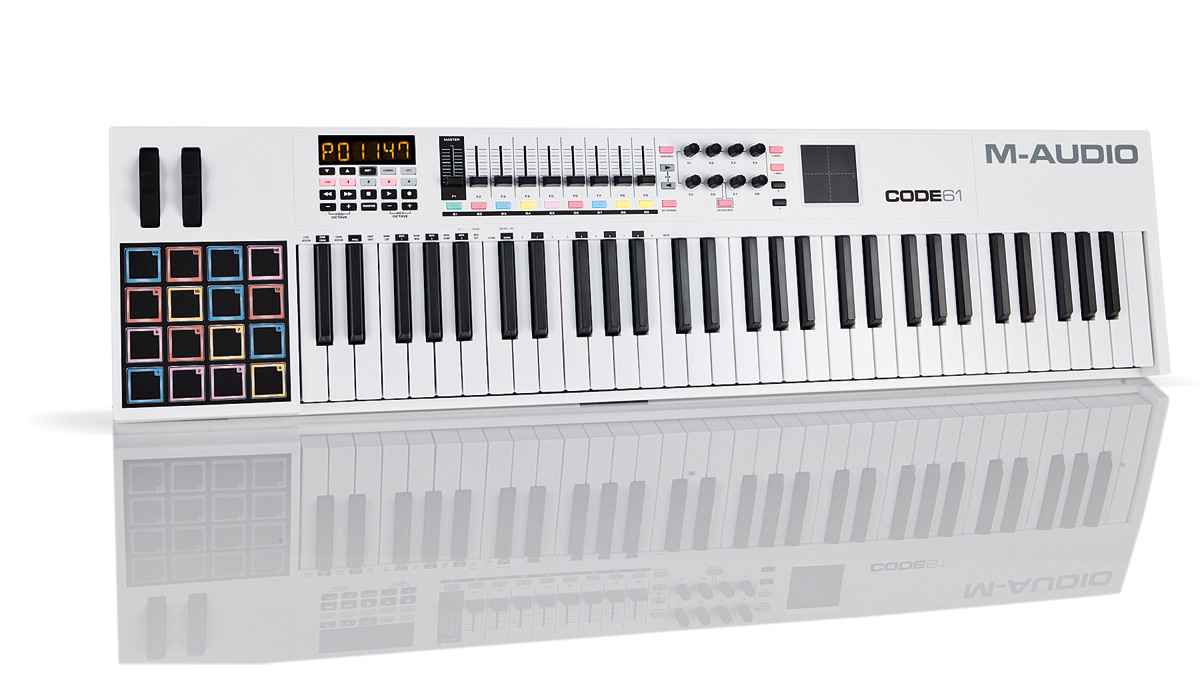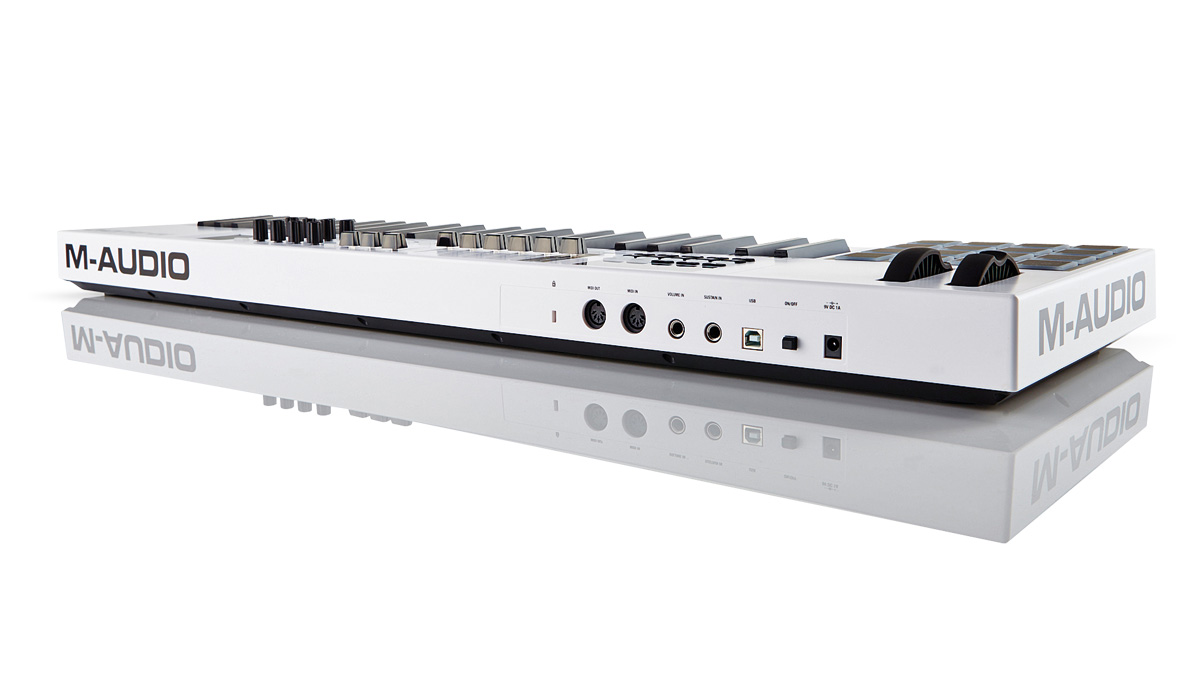MusicRadar Verdict
If you're looking for an in-depth controller for the studio or for the stage, Code is a keyboard controller happy to bask in the limelight.
Pros
- +
Full of features.
Cons
- -
Not the most intuitive.
MusicRadar's got your back

M-Audio Code Series 61-Key Controller

M-Audio Code Series 61-Key Controller
This 61-key controller sits atop M-Audio's Code range, ahead of the 25 and 49-key versions.
M-Audio's existing controller line-up contains instruments in several categories - including the long-serving Keystation, Oxygen and Axiom ranges - and to these, the Code series is now added.
Unlocking codes
This new model is buss-powered, using USB as its communication protocol, though it offers traditional MIDI In and Out ports as well.
The Code 61, offers a five-octave playing surface and a predominantly white front panel. If this sounds like a slightly vanilla colour choice, don't worry, you'll soon discover that Code is awash with colour elsewhere.
To the left of the keyboard, you'll find a four-by-four pad array, with all 16 pads offering velocity sensitivity. The middle panel of the main surface offers a slider bank with illuminated buttons below, while the screen to the left offers yet more light and colour.
The effect is reminiscent of other keyboard controllers including Native Instruments' light-tastic Komplete Kontrol S-Series range.
The feature line-up for the Code 61 is concluded by a pitch bend and assignable modulation wheel in the top left-hand corner and by an X-Y pad on the far right-hand side, which are equally configurable to the control parameters of your choice.
Special mention must go to the keyboard itself, which has been revised to produce a more 'playable' action. It certainly offers a much more expressive and responsive feel to that of my original Axiom Pro and, as it provides aftertouch as well as velocity sensitivity, it's a powerful control surface in its own right.
The keyboard can be split into four independent zones, which is great if you want to access multiple plug-ins at once.
Of course, with all of this potential, the burning question will be how well these options translate into practice. Is the Code series so bogged down in possibility that its learning curve is too steep to inspire creativity?
Code red, Code green
Well, there is certainly sufficient depth here to make reading the quick-start guide (and downloading the more extensive user guide) essential. To understand why, let's take the pads as an example section of the depth of capability Code provides.
By default, the pads will trigger MIDI notes upwards from C1, with the pads illuminated in different backlit colours changing again when pressed into action. To edit and assign a pad to a different note target, you need to press Edit, then press one of the pads, then a Ctrl Assign key (the keyboard's C1 key), then the Data 1 Key (F#1) and then use the Up/Down keys to move the note assignment to the key of your choice.
A similarly long chain of button presses is required if you're reassigning pads to become MIDI Control triggers instead and, while these chains do become more familiar over time, they don't start out that way.
That said, with plenty of presets onboard, the Code keyboards do make life very easy for those looking to have 'expected' controller needs covered, with sensible and helpful assignments offered by default. Indeed, as well as allowing you to work with 'regular' MIDI assignments within each controller section, the Code keyboards also provide HUI mode, if your DAW supports that protocol.
If so, the impressive light show, which glows at the heart of each section, switches to green to illuminate your choice of mode change. This is reflected from one section to the next, with the Fader and Encoder banks featuring dedicated buttons to allow you to slip from 'onboard' controller assignments to HUI-based ones. You'll soon associate the colours with their modes, making this part of the Code's operation pleasingly slick.
From X to Y
Perhaps the standout control feature offered on the surface of all three Code models, however, is the inclusion of an X-Y pad.
As with the Code's other control options, this is fully configurable so that your chosen parameters can be paired to the X and Y axes. There are further options too; the adjacent X and Y buttons instantly send the maximum value for the mapped control number, to facilitate parameter resets or creatively dramatic 'jumps', while there are separate colour-defined modes for the X-Y pad too. In Red mode, you're working with MIDI Controller assignments, while in Pink mode, you can use the pad to generate notes.
Lastly, when in Yellow mode, you can use the X-Y pad as a mouse track-pad for your computer.
M-Audio's reputation as a developer of feature-packed controller keyboards is further enhanced with the release of Code.
There's no doubt that the slew of multicolour control surfaces for Ableton Live and for systems like Maschine have impacted into the design offered here and there's definitely something of the 'light fantastic' about Code.
However, there's plenty of real substance here too. Yes, the learning curve is perhaps a little steep for editing the raft of controllers if you want to get busy under the hood.
That said, there are enough options here to ensure that might not be necessary.
“The last thing Billy and I wanted to do was retread and say, ‘Hey, let’s do another Rebel Yell.’ We’ve already done that”: Guitar hero Steve Stevens lifts the lid on the new Billy Idol album
"This $399 item will incur over $578 in additional import charges": Price of Sonicware CyDrums drum machine more than doubles thanks to Trump tariffs
“For guitarists who crave an unrelenting, aggressive tone that stands out in any mix”: The Fortin Meshuggah head is the amp every metal player wants – now you can get its crushing tones in a pedal









